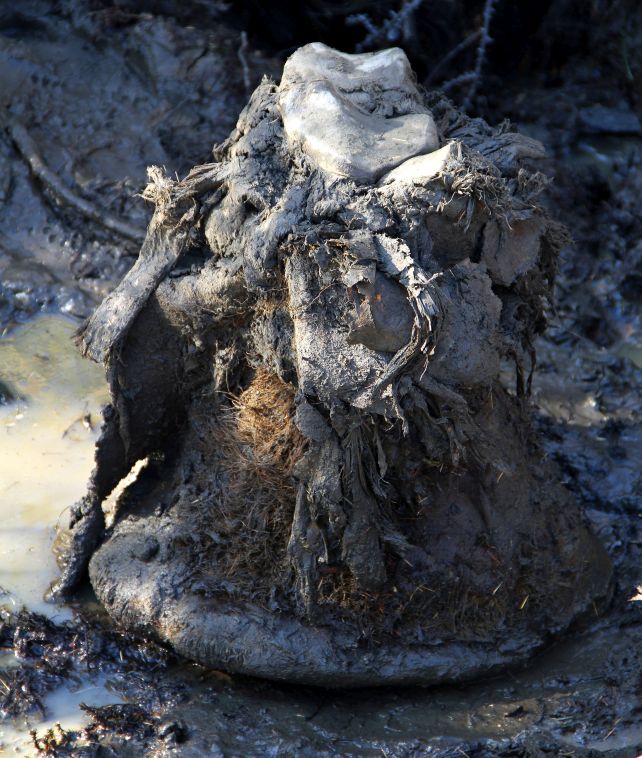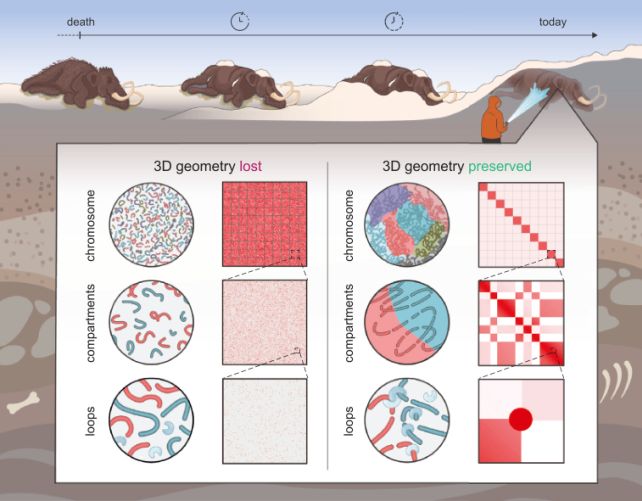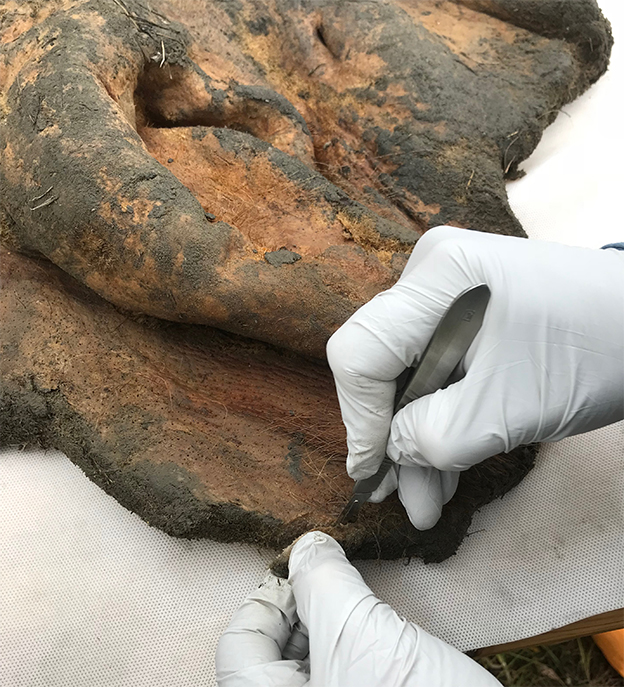ARTICLE AD
A fragment of skin trapped in permafrost for 52,000 years has just given us a marvelous world first.
Left by a wooly mammoth (Mammuthus primigenius), the material has delivered unto us not just a genome, but a three-dimensional reconstruction of the once-magnificent animal's chromosomes.
"This is a new type of fossil, and its scale dwarfs that of individual ancient DNA fragments – a million times more sequence," says geneticist Erez Lieberman Aiden of Baylor College of Medicine in the US.
"It is also the first time a karyotype of any sort has been determined for an ancient sample."
The last wooly mammoths died off around 4,000 years ago, leaving scientists to piece together their history and their lives through the traces they left behind. Because they were adapted to cold environments, many of their remains have fortunately been found in frozen places that serve as natural freezers, preserving more of their genetic material than might have been found otherwise.
 A preserved mammoth foot recovered from a permafrost environment. (Love Dalén)
A preserved mammoth foot recovered from a permafrost environment. (Love Dalén)In 2018, the Siberian tundra yielded remains of a female wooly mammoth that were exceptionally well-preserved. The specimen included not just bones, but skin tissue that a team of researchers thought might have preserved more of the beast's genetic material than anyone had previously recoverted.
That's because the mammoth appears to have been freeze-dried shortly after it died, a process that improves preservation by removing moisture by way of sublimation while freezing what remains. This mummification process preserves the material in a glass-like state – brittle, but relatively intact, like a piece of wooly mammoth jerky.
"We've known that tiny fragments of ancient DNA can survive for long periods of time," says genomicist Marcela Sandoval-Velasco of the University of Copenhagen and co-lead author of the study.
"But what we found here is a sample where the three-dimensional arrangement of these DNA fragments was frozen in place for tens of millennia, thereby preserving the structure of the whole chromosome."
 A diagram illustrating the preservation of the mammoth. (Sandoval-Velasco et al., Cell, 2024)
A diagram illustrating the preservation of the mammoth. (Sandoval-Velasco et al., Cell, 2024)That matters, because it gives us way more genetic information than just the piecemeal scraps we've recovered previously.
The entire genome of an organism is a sequence of billions of nucleotide bases that pair up to form a number of long, twisted polymers of double stranded DNA. These threadlike molecules wind back on themselves to form structures called chromosomes, allowing the genome to fit neatly inside the nucleus of a cell while protecting its more delicate sequences and facilitating expression.
Each chromosome can contain hundreds of millions of base pairs, though even in well preserved remains chromosomes quickly break down into pieces rarely much longer than around 100 base pairs.
The researchers took a piece of skin from behind the mammoth's ear, and used an analysis technique called Hi-C to help them figure out which parts of the puzzle go where. It was painstaking work that took several years, but eventually the team was able to map the mammoth's DNA, giving access to a whole range of new insights.
Firstly, they were able to determine that the wooly mammoth had 28 pairs of chromosomes – the first time we've been able to count them in an animal that died out so very long ago. This number makes sense, because the mammoth's closest living relatives, elephants, also have 28 pairs.
"By comparing ancient DNA molecules to the DNA sequences of modern species, it's possible to find cases where single letters of the genetic code have changed," says geneticist and co-lead author Olga Dudchenko of Baylor College of Medicine and Rice University.
"Fossil chromosomes are a game-changer, because knowing the shape of an organism's chromosomes makes it possible to assemble the entire DNA sequence of extinct creatures. This enables the types of insights that would not have been possible before."
 The primary sample from which the mammoth chromosomes were obtained. (Love Dalén, Stockholm University)
The primary sample from which the mammoth chromosomes were obtained. (Love Dalén, Stockholm University)This is because active and inactive genes tend to be spatially separated into different regions of the cell nucleus, a phenomenon known as chromosome compartmentalization. By comparing compartmentalization in mammoths and elephants, the researchers hoped to figure out why they are so similar, but also so different.
"The obvious question for us was: why is it a 'wooly mammoth'? Why isn't it a 'shockingly bald mammoth'?" says geneticist Thomas Gilbert of the University of Copenhagen.
"The fact that the compartmentalization was still preserved in these fossils was critical, because it made it possible to look, for the very first time, at which genes were active in a wooly mammoth. And it turns out that there are key genes that regulate hair follicle development whose activity pattern is totally different than in elephants."
This opens up a whole new world of study into the lives – and eventual demise – of the wooly mammoth. Although the preservation of the specimen is rare, even one set of chromosomes expands our knowledge into a new sphere.
And the team's analysis could be used to develop methodologies even for more degraded samples. They recommend testing it on a range of samples from different environments to see what kind of results might be just out there waiting to be discovered.
"Ancient Egyptian priests believed that mummification prepared a person or animal to be reanimated in a future life," they write in their paper. "They may have been closer to the mark than has been realized."
The findings have been published in Cell.

 4 months ago
39
4 months ago
39 

